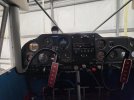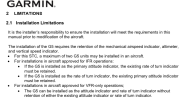Will Kumley
Line Up and Wait
Our new to us 1964 Piper Colt needed a new battery. Instead of just replacing it with the same type/model/series the wife opted to upgrade to a battery with better reviews from other pilots and shaved 15 pounds off our total airplane weight. Now she's thinking of other improvements we can make and I'm trying to keep things realistic, cost effective, and also not go nuts in the first year of ownership.
The picture below is the current panel. The AI, DG, and T&B are all vacuum driven off of a venturi system. Try as I might, this setup isn't great. The vacuum produced by the venturi is minimal (2-3" Hg). We've already checked the hoses and fittings. Although we found a missing hose clamp, it has made no impact on the vacuum pulled through the instruments at speed. I was considering installing a traditional vacuum pump as the plane did have it early in its life. This option is the cheapest option with minimal W&B impact but of course, everyone seems to be upgrading to digital and ditching their vacuum systems. After the battery upgrade the wife is now asking for options to upgrade the panel instruments/vacuum system and curious which route is ideal for us.
What feedback would you have in this situation?
Option A) Ditch the venturi, add a vac pump, new hoses, etc... Pros: Cheapest, relatively easy install, able to be done on field with my A&P/IA. Cons: maintains old instruments, will require regular maintenance on the vac pump, T&B may be non-working so it may need to be replaced regardless of which option we go with.
Option B) Remove vacuum system completely, install dual Uavionix AV-30s with the newly certified magnetometer. Pros: Improved instruments with digital info, may shave some weight off the plane. Cons: Cost, likely will need to be installed by an avionics shop which could result in more downtime.
Option C) Same as option B but with dual G5's. Pros/Cons remain the same.
** While I love the look of the GI275's I don't think I can justify the increased cost from the G5s considering what I'd be using them for. There will likely never be an autopilot installed in this plane.
End goal for the panel is to ultimately have IFR capability with a GPS navigator, Comm that allows me to monitor a 2nd freq, maybe upgrade the transponder to incorporate the ADSB-out requirement into it. Currently ADSB is accomplished via a skybeacon wingtip light and it works well with the existing transponder.
The picture below is the current panel. The AI, DG, and T&B are all vacuum driven off of a venturi system. Try as I might, this setup isn't great. The vacuum produced by the venturi is minimal (2-3" Hg). We've already checked the hoses and fittings. Although we found a missing hose clamp, it has made no impact on the vacuum pulled through the instruments at speed. I was considering installing a traditional vacuum pump as the plane did have it early in its life. This option is the cheapest option with minimal W&B impact but of course, everyone seems to be upgrading to digital and ditching their vacuum systems. After the battery upgrade the wife is now asking for options to upgrade the panel instruments/vacuum system and curious which route is ideal for us.
What feedback would you have in this situation?
Option A) Ditch the venturi, add a vac pump, new hoses, etc... Pros: Cheapest, relatively easy install, able to be done on field with my A&P/IA. Cons: maintains old instruments, will require regular maintenance on the vac pump, T&B may be non-working so it may need to be replaced regardless of which option we go with.
Option B) Remove vacuum system completely, install dual Uavionix AV-30s with the newly certified magnetometer. Pros: Improved instruments with digital info, may shave some weight off the plane. Cons: Cost, likely will need to be installed by an avionics shop which could result in more downtime.
Option C) Same as option B but with dual G5's. Pros/Cons remain the same.
** While I love the look of the GI275's I don't think I can justify the increased cost from the G5s considering what I'd be using them for. There will likely never be an autopilot installed in this plane.
End goal for the panel is to ultimately have IFR capability with a GPS navigator, Comm that allows me to monitor a 2nd freq, maybe upgrade the transponder to incorporate the ADSB-out requirement into it. Currently ADSB is accomplished via a skybeacon wingtip light and it works well with the existing transponder.



